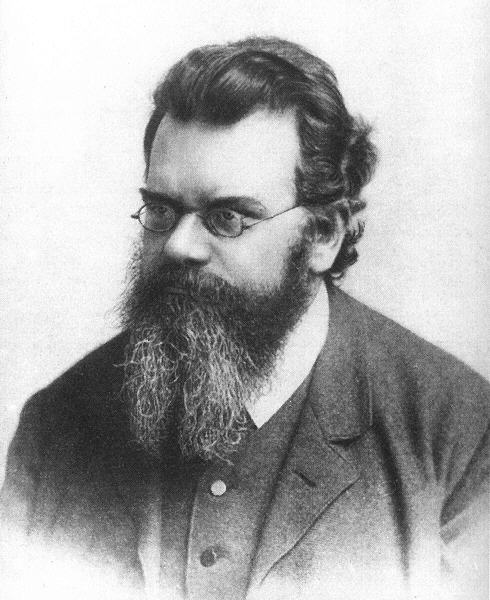<Back to Index>
- Physicist Ludwig Eduard Boltzmann, 1844
- Architect Ernst Carl Westman, 1866
- Marshal of France Louis Alexandre Berthier, 1753

Ludwig Eduard Boltzmann (February 20, 1844 – September 5, 1906) was an Austrian physicist famous for his founding contributions in the fields of statistical mechanics and statistical thermodynamics. He was one of the most important advocates for atomic theory when that scientific model was still highly controversial.
Boltzmann was born in Vienna, the capital of the Austrian Empire. His father, Ludwig George Boltzmann, was a tax official. His grandfather, who had moved to Vienna from Berlin, was a clock manufacturer, and Boltzmann’s mother, Katharina Pauernfeind, was originally from Salzburg. He received his primary education from a private tutor at the home of his parents. Boltzmann attended high school in Linz, Upper Austria. At age 15, Boltzmann lost his father.
Boltzmann studied physics at the University of Vienna, starting in 1863. Among his teachers were Josef Loschmidt, Joseph Stefan, Andreas von Ettingshausen and Jozef Petzval.
Boltzmann received his PhD degree in 1866 working under the supervision
of Stefan; his dissertation was on kinetic theory of gases. In 1867 he
became a Privatdozent (lecturer).
After obtaining his doctorate degree, Boltzmann worked two more years
as Stefan’s assistant. It was Stefan who introduced Boltzmann to Maxwell's work. In 1869, at age 25, he was appointed full Professor of Mathematical Physics at the University of Graz in the province of Styria. In 1869 he spent several months in Heidelberg working with Robert Bunsen and Leo Königsberger and then in 1871 he was with Gustav Kirchhoff and Hermann von Helmholtz in Berlin. In 1873 Boltzmann joined the University of Vienna as Professor of Mathematics and there he stayed until 1876. In
1872, long before women were admitted to Austrian universities, he met
Henriette von Aigentler, an aspiring teacher of mathematics and physics
in Graz. She was refused permission to unofficially audit lectures, and
Boltzmann advised her to appeal; she did, successfully. On July 17,
1876 Ludwig Boltzmann married Henriette von Aigentler; they had three
daughters and two sons. Boltzmann went back to Graz to take up the
chair of Experimental Physics. Among his students in Graz were Svante Arrhenius and Walther Nernst. He
spent 14 happy years in Graz and it was there that he developed his
statistical concept of nature. In 1885 he became a member of the
Imperial Austrian Academy of Sciences and in 1887 he became the President of the University of Graz. He was elected a member of the Royal Swedish Academy of Sciences in 1888. Boltzmann was appointed to the Chair of Theoretical Physics at the University of Munich in Bavaria,
Germany in 1890. In 1893, Boltzmann succeeded his teacher Joseph Stefan
as Professor of Theoretical Physics at the University of Vienna. Boltzmann
spent a great deal of effort in his final years defending his theories.
He did not get along with some of his colleagues in Vienna, particularly Ernst Mach, who became a professor of philosophy and history of sciences in 1895. That same year Georg Helmand Wilhelm Ostwald presented their position on Energetics, at a meeting in Lübeck in
1895. They saw energy, and not matter, as the chief component of the
universe. However, Boltzmann's position carried the day among other
physicists who supported his atomic theories in the debate. Thereafter in 1900, Boltzmann went to the University of Leipzig, on the invitation of Wilhelm Ostwald. After the retirement of Mach due to bad health, Boltzmann came back to Vienna in 1902. His students included Karl Przibram, Paul Ehrenfest and Lise Meitner. In
Vienna, Boltzmann not only taught physics but also lectured on
philosophy. Because of the great successes of Boltzmann’s philosophical
lectures, the Emperor invited him for a reception at the Palace. Boltzmann
was subject to rapid alternation of depressed moods with elevated,
expansive or irritable moods, likely the symptoms of undiagnosed bipolar disorder. He himself jestingly attributed his rapid swings in temperament to the fact that he was born during the night between Mardi Gras and Ash Wednesday. Meitner relates that those who were close to Boltzmann were aware of his bouts of severe depression and his suicide attempts. On September 5, 1906, while on a summer vacation in Duino, near Trieste, Boltzmann hanged himself during an attack of depression. He is buried in the Viennese Zentralfriedhof.